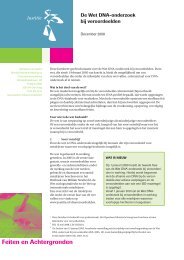INTERPOL HANDBOOK ON DNA DATA EXCHANGE AND PRACTICE
INTERPOL HANDBOOK ON DNA DATA EXCHANGE AND PRACTICE
INTERPOL HANDBOOK ON DNA DATA EXCHANGE AND PRACTICE
Create successful ePaper yourself
Turn your PDF publications into a flip-book with our unique Google optimized e-Paper software.
AnalysisThe data generated by electrophoresis is used to measure the size of the <strong>DNA</strong> fragmentsin a sample. From this, the number of STR repeat units that a person has at each locusis determined. This results in the creation of an STR-profile that is characteristic forthe person. It is not necessarily unique. Identical twins share the same STR-profile. It isfurther possible that two unrelated people share the same profile, which is a very rarephenomenon, however, that can be statistically well defined. The statistical evaluation ispart of the expert report and will be presented by court.history of dna profiling methodsRestriction Fragment Length Polymorphism (RFLP)The first technique applied in forensics was the analysis of restriction fragment lengthpolymorphisms. <strong>DNA</strong> is extracted from samples and cut by a sequence-specific enzyme(the so called restriction enzyme) before being separated by electrophoresis on anagarose gel on the basis of molecular weight. After being transferred by capillary action(blot technique) to a nylon membrane the polymorphic mini-satellite regions of the<strong>DNA</strong> are then examined by the addition of radioactively labelled pieces of a singlestranded <strong>DNA</strong> - called probes. A probe binds to its complementary sequence on themembrane, allowing it to be seen and compared with standards when the membraneis exposed to x-ray film.Multi Locus Profiling (MLP)The probes used in the early days of forensic <strong>DNA</strong> profiling involved the simultaneousanalysis of mini-satellite regions of the <strong>DNA</strong> and were called Multi Locus Probesresulting in Multi Locus Profiles (MLP). This method of analysis required relatively largeamounts of <strong>DNA</strong>, however (up to two micrograms). The interpretation of results fromsamples containing only a low amount of <strong>DNA</strong>, or from mixed samples was difficult andvery often impossible. Thus, only selected cases were suitable to be investigated usingthis method. MLP was superseded in the early 1990s by Single Locus Profiling (SLP)which looked into one defined spot of the human genome only.Single Locus Profiling (SLP)Different to the MLP analysis, where several regions of the <strong>DNA</strong> are examined inparallel within one process resulting in powerful information, a SL analysis can onlycontain the information of a single locus. The frequency of each <strong>DNA</strong> fragment detectedis estimated from a population database. To enhance the power of discrimination (inother words: to enhance the probability that a person that has the same profile as acrime scene stain really is the source of the stain), the process has to be repeated usingprobes for additional loci. In contrast to MLP, the SLP method can be used to resolvemixed samples, and the analysis can be carried out using less <strong>DNA</strong> (typically 0.5-1microgram), allowing for testing of smaller samples. However, one microgram is still aPAGE 90 APPENDIX 3what is forensic dna profiling?







